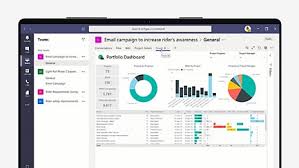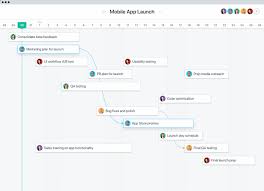Maximise Project Success with an Effective Project Planning Tool
The Importance of Using a Project Planning Tool
Project planning is a crucial aspect of any successful project. It involves defining the project goals, creating a timeline, allocating resources, and identifying potential risks. To effectively manage these tasks, it is essential to use a project planning tool.
Benefits of Using a Project Planning Tool:
- Organisation: A project planning tool helps in organising tasks, deadlines, and resources in one central location. This ensures that everyone involved in the project is on the same page and working towards the same goals.
- Time Management: By creating a detailed timeline with milestones and deadlines, a project planning tool helps in managing time effectively and ensuring that the project stays on track.
- Resource Allocation: With a project planning tool, you can easily allocate resources such as budget, manpower, and materials to different tasks. This optimises resource utilisation and prevents overallocation.
- Risk Management: Identifying potential risks and developing mitigation strategies is essential for project success. A project planning tool allows you to assess risks and plan accordingly to minimise their impact.
- Collaboration: Many project planning tools offer collaboration features that allow team members to communicate, share files, and work together seamlessly. This promotes teamwork and enhances productivity.
Popular Project Planning Tools:
There are various project planning tools available in the market to suit different needs and preferences. Some popular options include:
- Trello
- Asana
- Jira
- Microsoft Project
- Monday.com
Each of these tools offers unique features and capabilities designed to streamline the project planning process and improve overall efficiency.
In conclusion, using a project planning tool is essential for successful project management. It helps in organising tasks, managing time effectively, allocating resources efficiently, mitigating risks, promoting collaboration, and ultimately ensuring that projects are completed on time and within budget.
Eight Essential Tips for Effective Project Planning
- Clearly define project goals and objectives.
- Break down the project into smaller tasks and set deadlines for each.
- Allocate resources effectively to ensure timely completion of tasks.
- Use a Gantt chart or timeline to visualise the project schedule.
- Regularly communicate with team members to track progress and address any issues.
- Consider potential risks and have contingency plans in place.
- Review and adjust the project plan as needed based on feedback and changing circumstances.
- Document all decisions, changes, and important information throughout the project.
Clearly define project goals and objectives.
In project planning, it is crucial to clearly define project goals and objectives from the outset. By establishing clear and measurable goals, teams can align their efforts towards a common purpose, track progress effectively, and ensure that all activities contribute to the overall success of the project. Clear definition of goals also helps in setting realistic expectations, making informed decisions, and maintaining focus throughout the project lifecycle. When project goals are well-defined, stakeholders have a clear understanding of what needs to be achieved, which ultimately increases the likelihood of project success.
Break down the project into smaller tasks and set deadlines for each.
Breaking down the project into smaller tasks and setting deadlines for each is a fundamental tip in effective project planning. By dividing the project into manageable components, teams can focus on specific objectives, track progress more efficiently, and ensure that each task is completed within a specified timeframe. This approach not only enhances productivity but also helps in identifying potential bottlenecks early on, allowing for timely adjustments to keep the project on schedule.
Allocate resources effectively to ensure timely completion of tasks.
Effective resource allocation is a key tip in project planning that can significantly impact the timely completion of tasks. By carefully assigning resources such as budget, manpower, and materials to specific project activities, project managers can optimise productivity and prevent bottlenecks. Ensuring that the right resources are available when needed helps in maintaining a smooth workflow, meeting deadlines, and ultimately achieving project goals efficiently. Proper resource allocation is essential for maximising efficiency and minimising delays in project execution.
Use a Gantt chart or timeline to visualise the project schedule.
When utilising a project planning tool, incorporating a Gantt chart or timeline can significantly enhance the visualisation of the project schedule. By representing tasks, milestones, and dependencies in a graphical format, a Gantt chart provides a clear overview of the project timeline. This visual representation helps team members and stakeholders easily understand the sequencing of activities, identify critical paths, and track progress towards key deliverables. Incorporating a Gantt chart or timeline in project planning not only improves communication but also aids in effective resource allocation and time management throughout the project lifecycle.
Regularly communicate with team members to track progress and address any issues.
Regular communication with team members is essential when using a project planning tool to ensure the smooth progress of a project. By regularly updating and discussing the status of tasks, milestones, and potential issues, team members can stay informed and aligned with the project’s goals. This proactive approach allows for timely identification and resolution of any issues that may arise, fostering a collaborative environment where everyone is on the same page and working towards successful project completion.
Consider potential risks and have contingency plans in place.
When utilising a project planning tool, it is crucial to consider potential risks and establish contingency plans to mitigate their impact. By identifying possible obstacles or uncertainties that may arise during the project lifecycle, you can proactively plan for alternative courses of action. Having contingency plans in place ensures that the project remains resilient in the face of unforeseen challenges, ultimately increasing the likelihood of successful project completion within set timelines and budgets.
Review and adjust the project plan as needed based on feedback and changing circumstances.
It is essential to regularly review and adjust the project plan based on feedback and changing circumstances to ensure the project stays on track and meets its objectives. By staying flexible and responsive to feedback from team members, stakeholders, and external factors, you can address any issues or changes promptly, make necessary adjustments to timelines or resource allocation, and ultimately improve the overall project outcomes. This iterative approach to project planning helps in adapting to evolving requirements and maintaining project success throughout its lifecycle.
Document all decisions, changes, and important information throughout the project.
It is essential to document all decisions, changes, and important information throughout the project when using a project planning tool. By keeping a detailed record of these aspects, team members can easily track the evolution of the project, understand the reasoning behind certain decisions, and stay informed about any changes that may impact their tasks. Documenting information ensures transparency, accountability, and clarity within the team, ultimately leading to better project outcomes and smoother collaboration.





